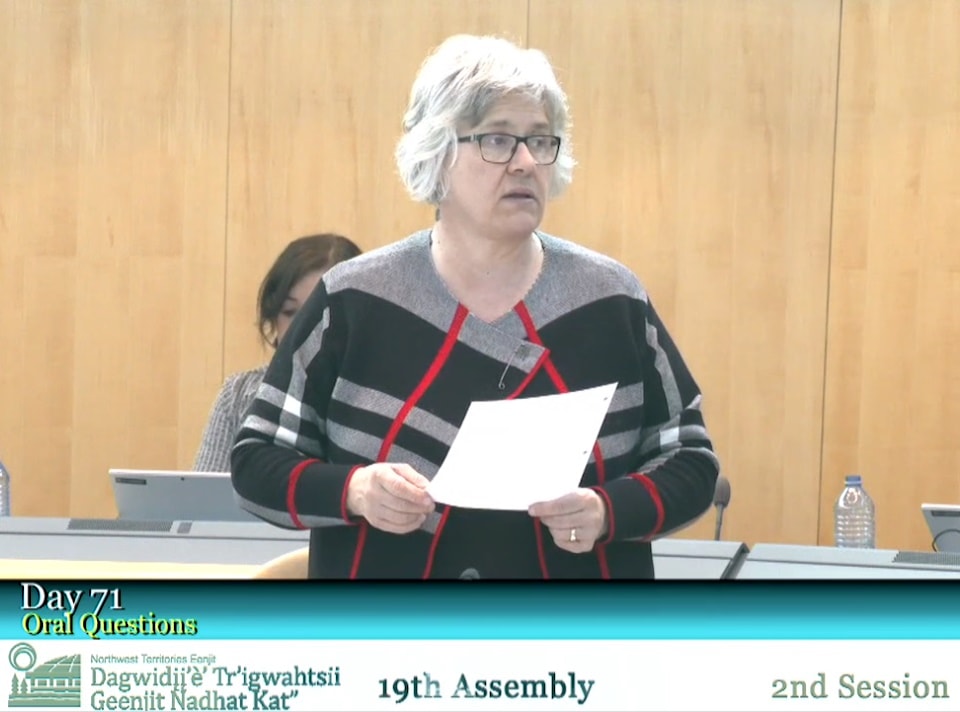The NWT’s goal of vaccinating 75 per cent of the eligible population by the summer is “now in question” due to changing circumstances, according to Health Minister Julie Green who spoke to the issue on Monday.
While discussing the easing of Covid-19 restrictions with Kam Lake MLA Caitlin Cleveland in the legislative assembly, Green said one factor in loosening the rules will be the progress of vaccinations.
Chief public health officer (CPHO) Dr. Kami Kandola said on March 10 that eased restrictions could come as early as April.
Those restrictions would relate to settings like business capacity, summer music festivals, family gatherings and weddings, Green said.
75 per cent in question
Green added the vaccination rate could affect Kandola’s review of the Emerging Wisely restrictions.
“The rate that we've all been discussing is 75 per cent,” she said. “I think that rate is now in question to some extent, given changing situations such as the variants and how transmissible they are, vaccine uptake, a number of other things that may change the immunity level that we require in communities to say that we are fully vaccinated.”
The health minister pointed to children and others who aren’t yet considered eligible for the vaccine.
“The whole business of how much is enough is really up for debate at this point. It depends on how well the vaccine protects against the variants, which I feel are now on the doorstep, now that we know there are variants in Yukon and Fort Chipewyan. It feels closer to home than ever before.”
Yukon reported a “variant of concern” on Thursday, and two cases of the B117 variant were reported at the Mikisew Cree First Nation in Fort Chipewyan on Friday, according to the CBC.
Easing rules depends on Covid-19 risk
Kandola explained in an email to NNSL Media on March 23 that the easing of restrictions depends on assessing the risks of Covid-19 to NWT communities.
Three factors in the assessment are monitoring the transmissibility and severity of Covid-19 variants; monitoring the effectiveness of vaccines, including how well they protect against variants; determining when the vaccine will be approved for everyone; and what measures should be kept in place to protect children under 18 and others who can’t receive the vaccine.
“The Office of the Chief Public Health Officer expects that scientific data on transmission should start to emerge in the coming weeks or months,” she said.
Asked what the health response should be if it’s discovered the vaccine prevents severe illness but doesn’t block transmission, Kandola said the NWT, Canada and other countries would re-evaluate the health burden of Covid-19 and review options to prevent death, illness and societal disruption.
In the NWT, that would require measures “that are the least restrictive” to protect people who can’t receive the vaccine.
“If a very high proportion of the Canadian population is vaccinated with a vaccine that effectively prevents severe Covid-19 outcomes and deaths, we will achieve pandemic goals,” Kandola said.
Community by community easing?
Cleveland also asked if restrictions could be eased in communities that have achieved higher vaccination rates.
She presented a scenario where Ulukhaktok has vaccinated 75 per cent of its eligible population and wants to return to engaging in regular pre-Covid-19 social activities versus Yellowknife where the vaccination rate is below 75 per cent.
“It would be really unfortunate to have surrounding communities really held back by their opportunity,” Cleveland said. “Likewise, it would also not benefit Yellowknife to be held to a standard of a community up in the Beaufort-Delta or in Nunakput. Not to put people against one another, but we will have different success at different points in time.
Green responded that it’s unclear if Kandola would make changes based on communities’ vaccine progress but that the GNWT doesn’t want to pit communities against each other.
“That is definitely one of the risks that the CPHO will be assessing in deciding what detail to release to the public in terms of vaccination levels, whether it is feasible to release by community or by region,” she said.
Territory-wide, there has been 58 per cent uptake of first doses of the vaccine and 36 per cent uptake of second doses, with community-level uptake ranging from 40 per cent to close to 80 per cent, Green said.
Demographically, the highest vaccination rates are among elderly residents, and the lowest is among the youngest residents.
Residents who are between 18 and 34 are “well below” the 50 per cent uptake in most communities, Green said.
A total of 23,722 first doses, and 13,933 second doses have been administered as of Friday, according to GNWT data.
The NWT’s fifth shipment of the Moderna vaccine also arrived on Friday, said NWT Health and Social Services Authority spokesperson Damien Healy. It contained 16,300 doses.
